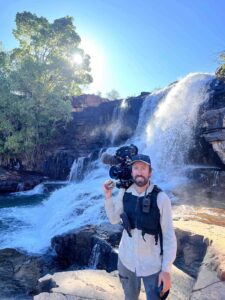Gavin Rawlings Hikes the Sony BURANO Through the Kimberley
Story Highlights
DoP and co-founder of Venture Films Gavin Rawlings has been using Sony cameras for over 20 years. Most recently the BURANO has been his camera of choice for most productions, complemented and supported by his Sony FX3 and FX6 cameras.
 Rawlings’ last adventure with this trio of Sony cameras was in the Kimberley region of Western Australia. A region that really knows how to put both camera and operator through their paces.
Rawlings’ last adventure with this trio of Sony cameras was in the Kimberley region of Western Australia. A region that really knows how to put both camera and operator through their paces.
Rawlings explains, “We produce a travel show on Channel 9 called ‘Oz Off Road’ which involves a lot of remote area travel around the country. These jobs require cameras that are reliable and the BURANO, FX3 and FX6 haven’t let us down yet. My most recent big project was seven weeks through the Kimberley. Here my A-cam was the BURANO paired with a Canon 30-105PL zoom.
“We did quite a few gorge walks and hikes on this trip. In those instances the BURANO was stripped down and I ran E-mount glass to lighten the camera up. B-Cam was an FX6 running a Tokina 16-28PL zoom. I was a solo shooter on this trip so just being able to pick up the BURANO or FX6 depending on what lens I needed really sped things up. C-cam was an FX3 on gimbal running a 24-70GM MKII. I love this setup and used it a lot for overlay footage on this project.”
Rawlings notes his clients were extremely happy with the Kimberley shoot and indeed all the projects he has delivered with Sony cameras adding, “We always get positive comments about how nice the image is whether it is a project we’ve taken through Resolve or just raw footage handed over.”
To that end Rawlings’ workflow involving Sony cameras is something he has refined over the years.
He continues, “Our workflows vary depending on the projects. For instance when we are filming the remote area travel shows like Oz Off Road, we shoot those shows in SLOG/X-OCN with the BURANO and generate proxies in camera. We’ll then use our Starlink connection to upload and organise those proxies onto our LucidLink cloud drive. From there I’ll usually create a FCP library in a fantastic app called PostLab which is designed for remote editing and collaboration. While I’m out in the field an assistant editor will be assembling edits and once I return I’ll take over and finish the edit. We then export an XML into Resolve and re-link to the original Sony footage and finish the grade. The SLOG and RAW footage is great to work with in Resolve.”
Other workflows require a much simpler approach where Rawlings can shoot XAVC using S-Cinetone or even ‘baking in’ a custom LUT so there’s minimal work to be done with the image in post. Something he remarks is, “great for those quick turnarounds.”
Rawlings has bought and used a veritable who’s who of Sony cameras over the years starting with the Sony VX2100 and including the EX1, FX3, FX6, BURANO and the Sony F55 which he used professionally for 12 years.
He adds, “The FX series cameras brought with them a whole new range of capabilities that were very useful to my line of work. In particular the dual base ISOs. This is why I added the FX3 and FX6 to my kit. Newer sensor technology, improved colour science, faster boot up speeds, 800 and 12000 base ISOs really helped all aspects of my film making – especially the ‘run and gun’ work. Plus being able to run a high-quality cinema camera like the FX3 on smaller gimbals is extremely convenient.”
All this led to Rawlings’ current camera of choice, the Sony BURANO, about which he explains, “To me the BURANO is the true successor to the F55. I love this camera. It offers incredible resolution, great codec options from X-OCN to XAVC, lots of different frame rate and imager mode options and the list goes on. Most importantly though, it’s reliable and produces great images. I have taken it on a TVC shoot in Chile, a 7-week film trip through the Kimberley, on tropical islands, corporate jobs, government jobs and more without any issues.
“I have a film trip to Finland this year and then Africa next year and am really looking forward to putting the BURANO through its paces in those locations. I love that with the BURANO one day I can be shooting with large PL cine zooms and the next I could be doing a smaller corporate video with G-Master glass taking advantage of the autofocus capabilities of this amazing camera.”
According to Rawlings, his shooting requirements change depending on his client. Some clients request footage to be shot and delivered in HD while others request 4K masters. Some request compressed codecs to adhere to budgets and others request acquisition in 4K + resolutions in RAW/X-OCN.
He continues, “That is the great thing about these Sony cameras. There is a camera for any project in my opinion. You can grab a small camera like the FX3 and shoot with ‘looks’ in camera or you can grab the BURANO, build it up as big as you want and capture 8.6K X-OCN.”
Rawlings has also shot with many other manufacturers’ cameras but according to him, it’s his Sony cameras that give him an edge as he concludes, “Sony’s cinema line cameras give a production an edge just by the sheer number of different cameras in their lineup. To have cameras like the FX30 all the way up to the Venice 2 and have similar looks is a huge benefit to any production. When an FX3 can cut into a project shot on a Venice — that’s pretty awesome.
“There’s also a couple of real standout wow factors about Sony cameras for me. One would be the image quality across the whole cinema line and the fact that the cameras can all intercut with each other pretty seamlessly. The other would be reliability. With the remote area projects and international work I need something reliable. The last thing I want is to be in the middle of nowhere and have a camera that’s not working. On our recent trip my drone rattled apart on the corrugated roads whereas all of my Sony cameras were completely unaffected — as always.”
